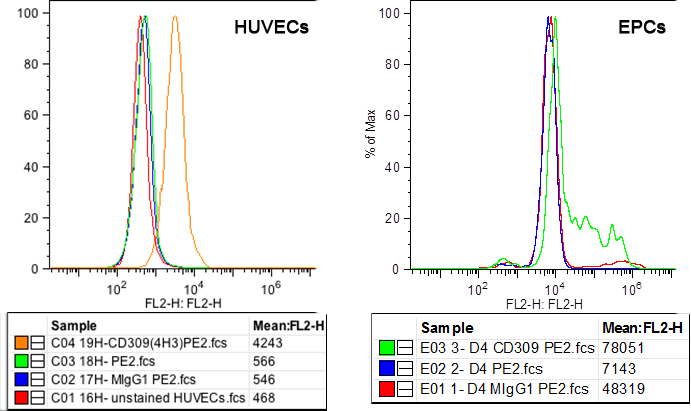anti-VEGFR-2/KDR (human) mAb (3(4H3))
| Code | Size | Price |
|---|
| AG-20T-0109-C100 | 100 ug | £380.00 |
Quantity:
Prices exclude any Taxes / VAT
Overview
Antibody Clonality: Monoclonal
Regulatory Status: RUO
Target Species: Human
Applications:
- Fluorescence-activated cell sorting (FACS)
- Western Blot (WB)
Shipping:
-20°C
Storage:
+4°C
Images
Documents
Further Information
Alternate Names/Synonyms:
Vascular Endothelial Growth Factor Receptor-2; KDR; FLK-1
EClass:
32160000
Form (Short):
solid
Formulation:
Lyophilized.
Handling Advice:
After opening, prepare aliquots and store at -20°C.Avoid freeze/thaw cycles.
Immunogen:
Recombinant human soluble extracellular VEGFR-2.
Long Description:
Monoclonal Antibody. The antibody will detect native human VEGFR-2/KDR in ELISA experiments and on the surface of different human cell types. Isotype: Mouse IgG1. Clone: 3(4H3). Applications: FACS, WB. Lyophilized. Disruption of the precise balance of positive and negative molecular regulators of blood and lymphatic vessel growth can lead to myriad diseases. Although dozens of natural inhibitors of hemangiogenesis have been identified, an endogenous selective inhibitor of lymphatic vessel growth has not been previously described. A splice variant of the gene encoding vascular endothelial growth factor receptor-2 (VEGFR-2) that encodes a secreted form of the protein, designated endogenous soluble VEGFR-2 (esVEGFR-2/KDR) has been described. The endogenous soluble esKDR inhibits developmental and reparative lymphangiogenesis by blocking VEGF-C function. Tissue-specific loss of esKDR in mice induced, at birth, spontaneous lymphatic invasion of the normally alymphatic cornea and hyperplasia of skin lymphatics without affecting blood vasculature. Administration of esKDR inhibited lymphangiogenesis but not hemangiogenesis induced by corneal suture injury or transplantation, enhanced corneal allograft survival and suppressed lymphangioma cellular proliferation. Naturally occurring esKDR thus acts as a molecular uncoupler of blood and lymphatic vessels; modulation of esKDR might have therapeutic effects in treating lymphatic vascular malformations, transplantation rejection and, potentially, tumor lymphangiogenesis and lymphedema.
NCBI, Uniprot Number:
P35968
Package Type:
Plastic Vial
Product Description:
Disruption of the precise balance of positive and negative molecular regulators of blood and lymphatic vessel growth can lead to myriad diseases. Although dozens of natural inhibitors of hemangiogenesis have been identified, an endogenous selective inhibitor of lymphatic vessel growth has not been previously described. A splice variant of the gene encoding vascular endothelial growth factor receptor-2 (VEGFR-2) that encodes a secreted form of the protein, designated endogenous soluble VEGFR-2 (esVEGFR-2/KDR) has been described. The endogenous soluble esKDR inhibits developmental and reparative lymphangiogenesis by blocking VEGF-C function. Tissue-specific loss of esKDR in mice induced, at birth, spontaneous lymphatic invasion of the normally alymphatic cornea and hyperplasia of skin lymphatics without affecting blood vasculature. Administration of esKDR inhibited lymphangiogenesis but not hemangiogenesis induced by corneal suture injury or transplantation, enhanced corneal allograft survival and suppressed lymphangioma cellular proliferation. Naturally occurring esKDR thus acts as a molecular uncoupler of blood and lymphatic vessels; modulation of esKDR might have therapeutic effects in treating lymphatic vascular malformations, transplantation rejection and, potentially, tumor lymphangiogenesis and lymphedema.
Purity:
Protein G purified.
Specificity:
The antibody will detect native human VEGFR-2/KDR in ELISA experiments and on the surface of different human cell types.
Transportation:
Non-hazardous
UNSPSC Category:
Primary Antibodies
UNSPSC Number:
12352203
Use & Stability:
Stable for at least 6 months after receipt when stored at -20°C.
References
Expression of vascular endothelial growth factor receptor-2 or Tie-2 on peripheral blood cells defines functionally competent cell populations capable of reendothelialization: G. Nowak, et al.; Circulation 110, 3699 (2004)



